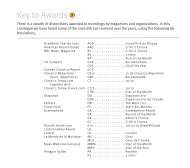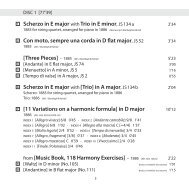MENDELSSOHN - Bis
MENDELSSOHN - Bis
MENDELSSOHN - Bis
Create successful ePaper yourself
Turn your PDF publications into a flip-book with our unique Google optimized e-Paper software.
other hand it is debatable whether can speak at all of the ‘completion’ of Sym -<br />
phony No. 4, which remained an unpublished ‘work in progress’ during Men dels -<br />
sohn’s lifetime.<br />
In the eighteenth and early nineteenth centuries, a journey to Italy – ‘the land<br />
where the lemons blossom’ (as Goethe expressed it in his famous Mignon-Lied),<br />
overflowing with testimonies from antiquity and the Renaissance – was an essen -<br />
tial part of any educated man’s career. Not least those pilgrimages that proved<br />
pro ductive in literary terms – undertaken by such figures as Winckel mann,<br />
Goethe and Herder – fuelled this urge to travel. It thus comes as no sur prise that<br />
in 1830, when Men delssohn set off for Italy via Weimar (where he visited his<br />
fatherly friend Goethe), he not only followed the tourist trail in order to become<br />
acquainted with a foreign country and long-gone epochs, but also kept his manu -<br />
script paper at the ready to preserve the impressions he received. As with the<br />
Third Symphony (the ‘Scottish’) and the concert overture The Hebri des, a music -<br />
al travelogue was planned.<br />
At first things went well: ‘The “Italian” symphony is making good progress’,<br />
Mendelssohn wrote in February 1831, and went on to predict: ‘It will be the hap -<br />
piest piece that I have written.’ Towards the end of a journey that lasted a year<br />
and a half, however, he laid the work aside in favour of other pieces. After re turn -<br />
ing home in the summer of 1832, awkward professional circumstances dis pelled<br />
any sunny moods. Mendelssohn’s hopes of succeeding his former teach er Carl<br />
Friedrich Zelter as director of the Berliner Sing akademie after the latter’s death in<br />
May 1832 came to nothing, not least as a consequence of anti-Semitism – even<br />
though Mendelssohn had scored triumphant success there in 1829 with the re -<br />
vival of Bach’s St Matthew Passion. In the creative crisis that followed, Men dels -<br />
sohn required an external impetus to persuade him to com plete his sketches. This<br />
came in November 1832 in the form of three commis sions from the Philhar mo nic<br />
17








